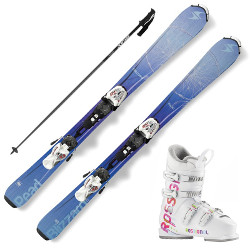It’s one of the oldest questions that skiers who travel to their destination often ask: should you rent skis and boots on your trips or buy your own? It is a good question, and one without a clear-cut answer. The arguments for and against are changing as the market and the way we ski has evolved and what used to be established reasoning is now not so clear-cut.
Established wisdom says that if you live near a ski resort or ski a lot you should buy your equipment, as it makes financial sense. If you ski just once a year for your annual vacation, then rent. But today our work and private lives are evolving. We are much more mobile than ever before and this has changed skiing habits. Today the average skier may not just ski once or twice, but five times a year or more. How should that affect your decision then?
 Why Rent Skis and Boots?
Why Rent Skis and Boots?
Firstly, we’ll look at the benefits of renting skis. The first thing to remember is that when you rent, you can choose skis for the snow conditions of the time. If things change on the slopes, you usually will have the ability to swap them for something more suitable. As ski technology has developed, this specialization for conditions has become more pronounced and has become a more important benefit of renting in recent years.
Renting also solves one of the most significant issues with skiing, and that is the effort of getting skis from your home to the snow. This is a major consideration if you have to travel a significant distance. Skis are unwieldy things. Awkwardly shaped, they take up a lot of room and are a nightmare in airports. This transport issue has also become more pronounced in recent years, particularly if you have to fly to reach a ski resort. With airlines slapping fees on extra bags and extra baggage weight, ski boots and skis are certain make a difference when it comes to your baggage cost. Plus, you’ll probably need to rent a vehicle with a car ski rack. All that cost might eat up some or much of the savings you expected to get while using your own skis and boots at the ski resort.
If you go this route, you definitely want to use a padded or hardcover ski boot bag, which will protect your skis (and all-important bindings) during the baggage handling process.
There is one other area where renting offers a real advantage – for those new to skiing. There is no point in pretending, skiing can be an expensive sport, skis themselves can be particularly pricey. If you are brand-new to skiing, renting makes a lot of sense. Why invest a large amount of money if you may not even ski more often than once every few years? As well, until you made it through that initial learning phase, you won’t really know how much you enjoy skiing. Unlike more personal items such as your ski jacket or ski goggles, things that you will definitely want to invest in even if you are new, skis can go from person to person with really very few lasting effects.
Also, rented equipment is almost always properly maintained and cared for. And caring for your own skis is something you really must do, so it is simply one less thing to consider if you choose to rent. We have noticed that the quality of available rental skis has gotten better and better during the past decade.
Finally, don’t forget the fact that kids will outgrow their skis, just like they do with all of their other clothing and gear. If you are buying skis for a child, consider going with a rental if the child is not an avid, every week skier. Many ski shops also offer lease programs for this exact reason.
Why Buy Skis and Boots?
Buying your own skis can be appealing for a few reasons. First, because you get that satisfaction of ownership. This may seem a little shallow, but there is something special about stepping into the skis and boots you bought for yourself.
More importantly, when you own the skis and boots, you can get comfortable with them, which can help you become a better skier. No more blisters from a boot that didn’t quite fit right. And even an entry-level downhill ski will give you a great experience if you buy a ski that matches your type of skiing.
Finally, you also get to choose which ones you have and what they look like. You will not be left to that whim of the rental shop, or the risk of getting a worn boot or ski if you try to rent during a busy week.
 For those who are a little flexible, buying skis does not have to be as hugely expensive as you may think. Ex-rental skis are usually up to date technology, have been well looked after, and offer a good savings over a brand new pair. You still get to choose, whether that is an ex-rental ski or the very latest model, it’s your choice. You can pick the skis you want, that suit you and your style, the right length, everything. Apart from the very lucky, that is never going to happen with rental. There will always be a compromise based on what is available at the resort you go to. Finally – and some would say most importantly – if you own your own skis, you will never have to stand in a queue at a ski rental store ever again!
For those who are a little flexible, buying skis does not have to be as hugely expensive as you may think. Ex-rental skis are usually up to date technology, have been well looked after, and offer a good savings over a brand new pair. You still get to choose, whether that is an ex-rental ski or the very latest model, it’s your choice. You can pick the skis you want, that suit you and your style, the right length, everything. Apart from the very lucky, that is never going to happen with rental. There will always be a compromise based on what is available at the resort you go to. Finally – and some would say most importantly – if you own your own skis, you will never have to stand in a queue at a ski rental store ever again!
If you buy your own boots, we would recommend investing in ways to transport them because they can get a little clumsy to carry. One option is a simple carrier strap. If you plan to travel with the boots, then definitely consider a ski boot bag both for protection and convenience. Having your own boots means that you probably can’t leave them at the resort or base area each evening, so you will be lugging around a couple pretty awkward and heavy pieces of equipment.
The costs. If you go skiing infrequently, renting will be cheaper — in fact, it can be a great way to save money on ski trips. The more you ski, however, the better it is to own your own. If you live near a resort, that is certainly still true, but what about people who travel? Transporting skis has becomes significantly costlier in recent years, with charges specifically for skis from airlines being normal these days. In addition, rental car costs can rise significantly if you need a larger vehicle just to transport your skis from the airport. That is significant expense every trip you will not have if you rent. Similarly, after each trip, you will also have the cost of maintenance to think about. Edge tuning and sharpening plus a wax after each trip adds yet more ongoing expenses.
If most of your skiing is driving distance, then you have an advantage of not having to check your ski bags. However, you might need some extra space in your car as it doesn’t take many skis to really fill up a vehicle. You can get a roof top ski rack, or if you want to protect your skis from the road debris, you can always get an enclosed roof cargo carrier (we like the Yakima Skybox Carbonite).
For a rental, you know the price; you have no travel hassle and will avoid airline surcharges.
 Conclusion
Conclusion
So, have travel cost increases made a difference? Yes. The point where skiing often enough to make buying financially worthwhile has probably shifted a bit. And for many who manage two or even three trips a year, especially those that are still learning and taking tuition, renting will likely be the more sensible option. However, for people who ski frequently, they are still better off buying, It simply makes more financial sense.
If you decide to buy, buy the boots first. That is the more important piece of gear for your comfort. The skis can come later.
If you are a Nordic skier dabbling in Alpine, or an Alpine skier trying some Nordic, then definitely rent. It does not make sense for you to own Nordic boots if you are only going to do it on occasion, and vice-versa.

Paul Miller is the Founder of Family Skier. He is an advanced skier and has extensive experience with family travel and ski schools. An accomplished skier, he has skied in 15 states and provinces and 6 countries. In addition to FamilySkier, his writing can be found on many ski-related websites, and as curriculum for many ski clubs in North America.




